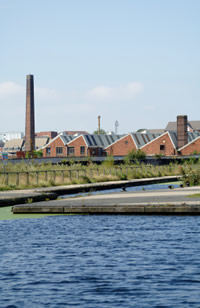 Planting willow trees and grass on derelict brownfield sites helps clean contaminated soil say scientists in the UK. They are embarking on a project to transform thousands of acres of former industrial estates.
Planting willow trees and grass on derelict brownfield sites helps clean contaminated soil say scientists in the UK. They are embarking on a project to transform thousands of acres of former industrial estates.
The process is known as phytoremediation and, despite its difficult name, it’s a simple method that works wonders. Scientists at the university of Teesside are taking swift action to expand their experiment based on the huge success of their pilot program, started in 2004, planting trees and bushes on polluted soil.
The University’s Clean Environment Management Centre (CLEMANCE) tested its method at a former enamel plant at Fylands Bridge in Bishop Auckham.
Their project, BioReGen (pdf), grows willow trees, miscanthus, reed canary and switch grasses. This vegetation cleans up the soil by absorbing contaminants such as zinc, copper, cadmium and heavy metals in coal ash.
Dr Richard Lord who leads the project said that when he started out he didn’t know if plants would grow at all on such contaminated land:
But it has been a success everywhere we have tried it. We have proved that phytoremediation works and what works on a small site can also do so on much larger sites,” he said.
The next brownfields that CLEMANCE is going to cover are at least one hectare each in size and have a soil history of heavy industrial use. With 1,155 hectares of brownfield land in the Tees Valley alone, the project is still a drip in the ocean.
However, it is likely that the method will catch on, because the cost of planting trees and plants runs in the thousands of euros per hectare, whereas other methods run up six figure bills.
CLEMANCE received 1.2 million euro grant from the European Union’s LIFE-Environment research programme. Dr Lord has been negotiating with energy provider SembCorp to provide willow trees for its wood-burning power station.
“[SembCorp has an appetite for timber] and we can help provide it, particularly if we expand our planting over larger areas”, said Dr Lord. “What started as a research project has found a commercial application.This is as sustainable as it gets.”


